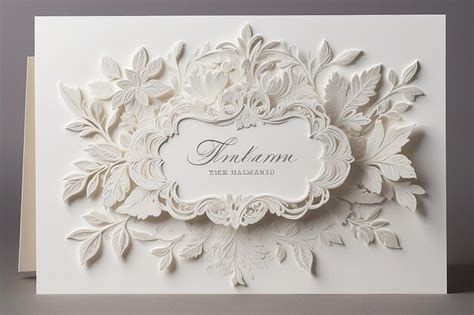In the digital age, it’s easy to forget the power of a heartfelt, handwritten note. Stationery thank you cards provide a tangible and meaningful way to express your appreciation, leaving a lasting impression on the recipient.

The Importance of Thank You Cards
According to the Emily Post Institute, a leading etiquette authority, sending a handwritten thank you note after receiving a gift or gesture of kindness is “a gracious and respectful way to acknowledge someone’s thoughtfulness.” Here’s why:
- It shows that you care: A handwritten note conveys a level of personal attention and effort that is often missing in electronic communications.
- It deepens relationships: Expressing gratitude strengthens bonds and fosters mutual respect.
- It makes a lasting impression: A physical card can be kept as a keepsake, serving as a tangible reminder of your appreciation.
Choosing the Right Stationery
The choice of stationery for your thank you cards can impact the overall tone and message you convey. Consider the following factors:
Paper: Opt for high-quality paper with a smooth surface that allows for easy writing. Linen or cotton paper adds a touch of elegance.
Weight: Choose paper weight appropriate for the occasion. For formal thank yous, a heavier weight (around 100 lbs) provides a substantial feel.
Color: White or ivory paper is the most versatile, but you can also experiment with colors that reflect your personality or the occasion.
Border: A simple border can add a decorative touch without distracting from your message.
Crafting the Perfect Thank You Note
While there are no strict rules for writing thank you cards, a few guidelines can help ensure your message is clear and impactful:
Start with a warm greeting: Begin with “Dear [Recipient’s Name]” or a more formal greeting if appropriate.
Express your gratitude: Clearly state why you are writing and what you are thanking the recipient for.
Be specific and personal: Take the time to mention specific details that show you were paying attention.
Keep it concise: Your note should be brief and to the point, but avoid being too impersonal.
Close with sincerity: End with a sincere expression of gratitude, such as “Thank you again for your kindness” or “I deeply appreciate your support.”
Common Mistakes to Avoid
To ensure your thank you cards make a positive impression, avoid these common pitfalls:
- Using generic language: Avoid boilerplate phrases that lack authenticity.
- Missing key details: Be sure to include the specific occasion or reason for your gratitude.
- Writing too late: Send your thank you cards promptly to show that you appreciate the gesture while it’s still fresh in the recipient’s mind.
- Over-using embellishments: Stick to simple, elegant stationery and avoid excessive decorations that can distract from your message.
FAQs
How soon should I send a thank you card?
As soon as possible after receiving the gift or gesture. Generally, aim to send it within one to two weeks.
Is it necessary to send a thank you card for a gift of money?
Yes, it is considered appropriate to send a thank you card for any gift, regardless of its nature.
Can I send a thank you card via email?
While an email thank you is better than none, a handwritten card is still considered more personal and meaningful.
How do I address a thank you card to a business?
Address it to the company name followed by the contact person’s name:
Company Name
Attention: [Contact Person's Name]
Personalize your cards: Include a handwritten signature, a personal message, or a small doodle that adds a touch of warmth.
Consider using a thank you note template: This can save time and ensure consistency while still giving you room for personalization.
Send a thank you gift: A small gift, such as a box of chocolates or a gift certificate, can complement your thank you card and show your appreciation in a tangible way.
Table 1: Paper Types for Stationery Thank You Cards
| Paper Type | Description |
|---|---|
| Linen | A premium paper with a luxurious texture |
| Cotton | A soft and smooth paper, ideal for writing and printing |
| Laid | A paper with a subtle ribbed texture that adds character |
| Parchment | A translucent paper that provides an antique look |
| Vellum | A heavyweight paper that is both durable and elegant |
Table 2: Popular Stationery Brands for Thank You Cards
| Brand | Known for |
|---|---|
| Crane & Co. | Classic and elegant stationery |
| William Arthur | Modern and stylish designs |
| Rifle Paper Co. | Colorful and whimsical patterns |
| Paper Source | A wide variety of designs to choose from |
| Kate Spade | Chic and sophisticated stationery |
Table 3: Types of Thank You Cards
| Card Type | Features |
|---|---|
| Flat Cards | Single-layer cards that can be folded in half |
| Folded Cards | Cards that fold out to reveal a larger writing area |
| Notecards | Smaller cards that are perfect for brief thank yous |
| Letterhead | Professional-looking cards with the sender’s name and address printed at the top |
| Pre-Printed Cards | Cards with a printed thank you message, allowing for easy personalization |
Table 4: Etiquette for Sending Thank You Cards
| Occasion | Timeframe |
|---|---|
| Gift | Within one to two weeks |
| Invitation | Within three to four weeks |
| Condolence | Within a few days |
| Job Interview | Within 24 hours |
| Business Correspondence | Within a few days |
